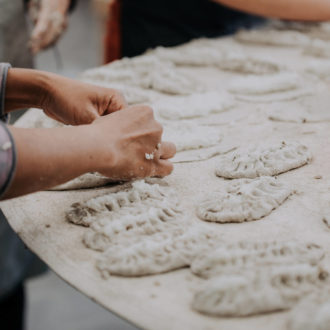“I encourage my staff to heighten all their senses when they cook,” says Mikkola.
He speaks highly of the value of paying careful attention when selecting ingredients. “You need to use various flavour profiles and be creative and innovative. I often pickle or ferment some of the vegetables in order to get different layers for the meals.”
Traditional Finnish preserves, jams, pickles, dried mushrooms and fermented vegetables contribute tantalising layers of flavour and texture.
“In our kitchen, there is hardly any food waste,” says Mikkola. “The main ingredients are local vegetables.”
Farm and forest

“The old methods of preservation – making jams, pickling, salting and drying food – are still used to achieve interesting textures and flavours,” says Kim Mikkola.Photo: courtesy of Kim Mikkola
Finns appreciate local, seasonal produce. Summer brings a variety of green vegetables and autumn is a time for foraging.
“We pick berries, mushrooms and many herbs in the forests and the offering is very rich,” says Mikkola. “I believe it is our fantastic air and water quality that makes the food healthy and tasty.”
Many Finnish people associate winter with root vegetables that can be stored for long periods, such as rutabagas, beets, turnips, parsnips and potatoes. Winter is also a time to enjoy berry jams, pickled vegetables and dried mushrooms that are prepared in the summer and autumn.
“Nowadays, many vegetables are grown in greenhouses throughout the year, so we have more local options available during the winter,” says Mikkola. “Even so, the old methods of preservation – making jams, pickling, salting and drying food – are still used to achieve interesting textures and flavours.”
Inari is a Helsinki-based restaurant, but the name refers to an area of Finnish Lapland, in the far north. At the time of writing, Mikkola has closed the restaurant’s previous brick-and-mortar home, and plans to reopen at another location in the future. In the meantime, Inari has become nomadic, appearing in different places and finding new customers wherever it goes. The restaurant’s name continues to stand for the exceptional staff who surround Mikkola.
Recipe: Inari green curry

“In our kitchen, there is hardly any food waste, says Mikkola. “The main ingredients are local vegetables.”Photo: Santeri Stenvall
Prepare the greens:
- Peas (raw)
- Fava beans (blanch* them and then pop them out of their skin)
- Romanesco, cut and blanched
- Spinach, washed and cut, raw
- Broccoli, cut and blanched
- Thai basil leaves, washed
- Coriander (cilantro) leaves, washed
- Samphire, washed and cut (tastes like asparagus)
- Asparagus, blanched and cut
- Broad beans, blanched and cut
- Green jalapeno (remove seeds and cut)
*Blanching means putting the vegetables into boiling water for a minute or so, then halting the cooking process by adding ice water.
Proceed to make Inari green curry paste as follows:
- 6 Thai green chilies or regular green chilies, chopped (adjust the strength of the curry by varying the amount of chilies)
- 2 shallots, chopped
- 2 lemongrass stems, trimmed and finely chopped
- 6 lime leaves (Makrut lime), chopped
- 5 cloves garlic, chopped
- 2 tsp lime zest, grated
- 1 tsp ground coriander
- 1 tsp ground cumin
- 1/4 tsp white pepper
- 1/4 tsp turmeric
- 200 ml chopped coriander or cilantro leaves
- 200–300 ml neutral oil (rapeseed, sunflower seed)
Mix everything together into a paste in a food processor. Fry the paste in a pot on low heat.
Prepare dashi (also known as the base for miso soup): Put 23 g kelp in 1 litre of water and heat to 70 degrees Celsius for 1 hour. Strain it and keep the water.
Bring the water to a boil. Add 10 percent katsuobushi (dried and fermented tuna). Infuse for 15 minutes. Strain the mixture and keep the liquid. Add the dashi into the paste.
Having sautéed the curry paste in a pot and then added the dashi, bring it to a boil. Leave it to rest for 5 to 15 minutes and strain. Add cream. Adjust the sauce with xantana (fermented corn starch) and butter. Pour the sauce over the vegetables. Season with lime juice, fish sauce, lime leaves and/or lemongrass.
By Päivi Brink, ThisisFINLAND Magazine 2023
















